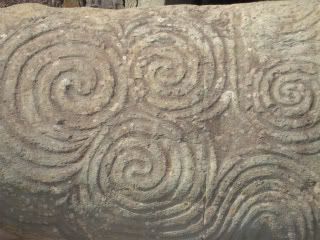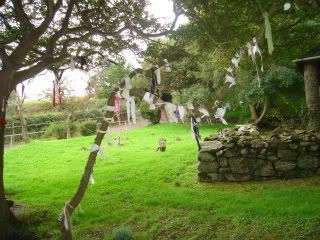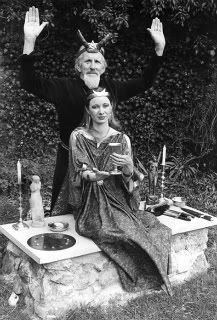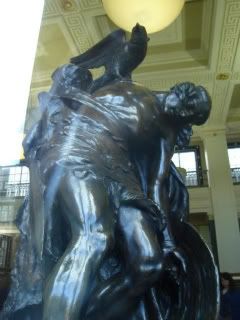Dé hAoine 2 lá de Mhí Aibreáin 2010
Ireland is often described as a "magical place" in literature, and modern tourist brochures. Those words are indeed hard to separate from the landscape, mythology, literature, and poems that have been expressed by so many writers produced by this unique island. Magic is a term open to personal interpretation to many people, with a wide range of definitions under its label. More specifically, I'm here to describe its role in Irish paganism.
Magic(k) can be viewed in correlation with religion, a secular art no different from playing the harp, or plain superstitious nonsense. Regardless of how it's viewed, it remains a practice included by many pagan, and neo-pagan religions and spiritualities. Some cultures have held its crafters in high regard, and others have deemed it a hubris, impious art. With regards to paganism, it has become the face of so many forms of occult& popular neo-pagan paths, that others have felt a strong need to disassociate with its use&term, that don't identify with it. In regards to Irish tradition, I've noticed a trend in so many Celtic Reconstructionist paths, to avoid anything remotely close to it, in an effort to dissociate with other forms of paganism like Wicca, that have popularised its use, whilst overlooking strong elements of Irish tradition in the process. I'm going to explore its use among Irish tradition, in more detail....
First of all, with all of the definitions around for magic(k), the most commonly used definition for magic today, is that coined by the famous occultist, Aleister Crowley, " Magic(k) is the Science and Art of causing Change to occur in conformity with Will."
Crowley added the extra "k," in his own words from Book 4,," The old spelling MAGICK has been adopted throughout in order to distinguish the Science of the Magi from all its counterfeits," thus distinguishing it from the illusionary trickery of stage magic. It was under this form, that it was said to have been created in the East among the Magi priests of pre-Semetic&Aryan times, associated with Zoroaster. Irish scholar and leader of Irish Literacy Revival, T.W. Rolleston, explains more about its roots with the Celts on page 33 of the section, The Religion of Magic, under the chapter,The Religion of The Celts, in his book, Celtic Myths and Legends...
"The first magicians were those who attained a special knowledge of healing or poisonous herbs; but "virtue" of some sort being attributed to every natural object and phenomenon, a kind of magical science, partly the child of true research, partly of poetic imagination, partly of priest-craft, would in time spring up, would be codified into rites and formulas, attached to special places and objects, and represented by symbols"...and further summing up Pliny's take on it, "Magic was not-so Pliny believed-indigenous either in Greece or Italy, but was so much at home in Britain and conducted with such elaborate ritual, that Pliny says it would almost seem as if it was they who taught it to the Persians, not the Persians to them."
Druid is a term used interchangeably(often mistakenly) among groups of the learned sect of Ireland, that ranged from poets, philosophers, doctors, lawyers, priests, and magicians. Strabo stated in Greek that, "Among all the tribes, generally speaking, there are three classes of men held in special honour; the bárdoi, the ováteis, and the druídai."
Dáithí Ó hÓgáin, professor at University College Dublin, who was awarded the Irish Fleadh Cheoil na hÉireann award Ard Ollaibh for lifelong service to Irish traditions, explains on page 80-81 in his book The Sacred Isle: Belief And Religion In Pre-Christian Ireland...
"Celtic scholars are agreed that the proper forms of these three words are bardi, vátes, and druis. In Irish they are well attested as bard (a term for a minor poet or reciter), fáidh (a prophet) and druí (a druid or magician)"
He further states," "the simplest, and yet the most telling, evidence for the supernatural skills of the druids in ancient Ireland is furnished by the word for druidry itself, druídecht. This (in modern spelling draíocht) has always been the ordinary term in Irish for magic."
Being members of the priestly caste, as well held in high regards in other positions of society, the druids were looked upon as the intermediaries of the supernatural, and of the Gods&man. There are those that believe that magic is a word of Christian propaganda used to make any pre-Christian Irish tradition appear heathen and sinful. However, The Irish language constantly updates itself, and there are people that make a good living in charge of coming up with new words in Modern Irish such as gluaisteáníocht(motoring), and bogearraí ríomhaire)computer software. If indeed the term was outdated, then it would seem unlikely for it to appear in Foclóir Gaeilge-Béarla by Niall Ó DÓnaill, the "Bible" modern Irish-English dictionary referred to by some many teachers of the language, on page 441,"
draíocht, f.(gs&pl.~a) 1.Druidic art, druidism Lit.~a druadh, druidic arts. 2. Witchcraft, magic; charm, enchantment."
The Christian resentment is attested in other elements, as Francis J. Byrne; Emeritus Professor of Early Irish History at University College Dublin, puts in his book Irish Kings and High-Kings on page 13, " The Irish word Druí (plural Druíd), is usually rendered magus in Hiberno Latin texts, where druids often figure as opponents of Patrick and other saints". This was kept in mind during the áes dána Irish law. When bishops and lectors took over the druidic roles with the triumph of Christianity. It affected the social structure to where, as Byrne continues, "The ollam or highest degree among the learned caste, was equal in legal status to a king or bishop. The ollam inherited the mantle of the ancient druid, but the druí as such, the practitioner of magic, was degraded under the new dispensation to unfree status."
There's no hiding the belief and importance of magick in the legends, cast all over the island by the Gods, otherworld entities, and man. Mythic figures such as the Druid Cathbhadh of the Ulster Cycle, and the Witch Fedelm "Red Mare", daughter of Móethaire linked with written references to palmistryin pseudo hagiological tracts are found constantly weaving their spells in the myths. The seer warrior heros, Finn mac Cumhaill, and Cú Chulainn, were even hinted at possessing such occult knowledge themselves. A warrior killed by the hand of Cú Chulainn, Cailtín, had children that were sent abroad to study magick as far as Babylon under the order of Queen Meadhbh, in order to come back and avenge their father by supernatural means.
Aside from the mythology, Irish literature going back to the early 7th century refers to the file, druí, and fáidh to have an extensive sort of magical, antiquarian knowledge called imbas. To distinguish these practices considered "magickal", from others not containing to another definition of magick, these are practices that are indeed examples of causing change to occur with conformity of will. We read of rites such as imbas forosnaí where the druid discovers any knowledge that he wills. There were charms and spells for almost every facet of life, from banishing uncomfortable ailments, to discovering the identity of cattle thieves. Other skills like the imbas forosnaí, such as teinmlaída, and díchetal do chennaibh, were essential to every ollamh, and druí. The Fíle were believed to have the ability to compose powerful praises, and satires, that were even said to have the ability to cause men to fall ill or die with a justifiable composition. Their skills weren't even limited the battle field, another examples in literature are making of glam díched to Lugh, while "calling on the 'strong druidic skills' to destroy the enemy through the forces of the sky and soil, sun and moon" appears.
This ancient, almost ignorant belief of effective destruction magic was a reality, so much so that it was actually believed that the druids had control over the elements, to an exaggerated extent that Christian missionaries used a propaganda with claims that the druids stated that they created, “heaven and earth, sea, sun, and moon” themselves.
The magickal persona of poets survived the advent of Christianity, all the way down to recent times. Their status was about equal with the bishops, and it is believed that they preserved much of the druidic traditions under this guise. It was believed they had the ability to even satirise down the kings themselves, and pg. 12 of Ó hÓgáin's Irish Superstitions, " Medieval Irish literature claims that poets had two capsules on their tongues-one full of honey for praising, the other full of poison for satirising." This of course resembles the dual nature of the poetic skills, moladh agus aoir, praise&satire. Folk magick preserves folk thought of the ancient world, all the way down to the last traditional refuges of na Gealtachta, where charms and curses centered around crops, livestock, and around blessing&cursing stones still linger. The Carmina Gadelica is a book of Gaelic prayers, hymns, charms, incantations, blessings, runes, collected in the Highland of Scotland. The traditions are of Christian nature, however the pagan origins are obvious, with the exact words curse, charm, and incantation used in a Christian context, translated from Gàidhlig.
Other paths within Celtic Spirituality have rejected the use of magic because of its link with neo-paganism, and ceremonoal magick, such as casting circles, and calling quarters. However any learned practitioner of such will tell you that these practices are ancient in origin. Evocations are in a way no different from the glam díched, a sort of ritual posture described above, when invoking Lugh. Circles are universal tools in many cultures, with neolithic stone ones used in magico-religious ritual obvious all over this island. Referring back to The Sacred Isle...
"The form of a circle occurs widely in magic and religion as a protective device, or a technique for emotionally controlling the cosmos. It is therefore not hard to imagine that those who constructed these circles in Ireland would assemble within them on certain occasions in order to gain ritual protection for their communal, and perhaps individual welfare...when circumambulation is employed in ritual practice, it is considered correct to move in the same direction as the sun."
This Irish custom occurs in many folk traditions, and the direction sunwise, deiseal, referring back to Foclóir Gaeilge-Béarla, " deiseal, m(gs.-sil 1. Righthand directio, direction of the sun." This is course being the root of the British Witchcraft's Deosil.
Celtic paganism is open to personal interpretation due to virtually no written records of primary sources regarding religion. However written second hand sources, etymology, native vernacular, and probable archaeological evidence indicate magic was, and is, present in Ireland, and was used to a certain extent in pre-Christian religious rituals.
Friday, 2 April 2010
Tuesday, 30 March 2010
Tionscnamh(Introduction)
Dé Máirt 30 lá de Mhí Mhárta 2010
"Ireland alone was never even visited, much less subjugated, by the Roman legionaries, and maintained its independence against all comers nominally until the close of the twelfth century, but for all practical purposes a good three hundred years longer
Ireland has therefore this unique feature of interest, that carried an indigenous Celtic civilisation, Celtic institutions, art, and literature, and the oldest surviving form of the Celtic language, right across the chasm which separates the antique from the modern world, the pagan from the Christian world, and on into the full light of modern history and observation."
-Thomas.W. Rolleston

A lot of this page is dedicated to all of the pagan practices, and traditions in Ireland. From the native indigenous, pre-Christian practices, Traditional paganism, occultism, neo-paganism, this island is rich with all of them.
"Pagan" is a label, and umbrella term that can be used in a variety of definitions. In Irish, Págánach is obviously a Latin loan word, used to describe the pre-Christian beliefs&practices of the island. It's a word that continues to be linked with the island to this day, found in Irish text books, literature, and tourist brochures. A brief introduction...
Said to have come to an end, at the end of the 5th century a little over a hundred years after St. Patrick's legacy of banishing the "snakes," Diarmait mac Cerbaill is said to have been the last High King of Ireland to have been inaugurated with the pagan ban feis marriage, to the Goddess of the land, ritual at Tara. The druid roles were officially said to have been completely replaced by bishops and lectors after him, as they broke down into the ranks of the poets, whose captivation on the Gaelic mind is almost frozen in time. The peaceful triumph of Christianity was able to happen because of the adoption and syncretisation the new religion was able to do with the old. Celtic Christianity was the Christianity that led the rest of Europe through the dark ages, and because of this we can actually credit the church for preserving, and recording our native traditions for us. The old beliefs of the otherworld communities remained, with the worship of the old regional patron deities simply passed down into saint veneration. Paganism has remained present in the tales of the seanchas, the many sacred sites that dot the landscape, the Irish language itself, along with traditional folk customs.

The Inquisition barely touched here, and the few recorded instances are credited to the influence of foreign clergy. Folklore of traditional witches such as Biddy Early are remnants of active paganism in a society where such people indeed considered themselves Christian, before the New Age movement.
The Irish literacy revival of the 18th century sparked a new found interest in Gaelic mythology, literature, and poetry in an archaic stance against modernism. The Neo-Druidic movement birthed from antiquarian figure heads of that time, which remains part of a roughly 300 year old tradition now. Druids in Ireland today currently maintain lineage from the likes of Druids such as George Watson MacGregor Reid. One of the main faces of the Irish Literacy Revival was William Butler Yeats, who also happened to be a member of the Hermetic Order of the Golden Dawn. Another member of this magic(k)al order, and acquaintance of Yeats, was the famed occultist, Aleister Crowley. Crowley was the head of the O.T.O in Great Britain and Ireland, that later became his Thelemic magickal order.
Because of Alexandrian Witches Janet&Stewart Farrar, Ireland was famously given its lineage to another major player responsible for introducing paganism to the public, Gerald Gardner. With the Farrar's more specific form of Alexandrian Wicca, directly handed down from Alex Sanders, Ireland gained its public introduction to the initiatory mystery tradition of Wicca.

All of the influences from these people and groups, are strongly felt in Irish paganism today in modern groves, covens, clanns, orders, e.t.c. Aside from being the "Celtic" homeland so influential in Celtic spirituality, with Ireland being the only Celtic nation in history untouched by the Roman empire, with the bulk of Celtic myths indeed being Irish, there is also a wide variety of traditions, and Gods adored on the island. The Fellowship of Isis was founded here at Clonegal Castle in 1976. Deities from Egyptian, Mesopotamian, Greek, e.t.c pantheons are all worshipped due to the growth of paganism, and neo-paganism in modern society today.

One path that I didn't give much attention to is Celtic Reconstruction Paganism. This is a scholarly path with a methodology that reconstructs historic pre-Christian Celtic practices modified for a modern context, whilst utilising sources such as the myths of native vernacular, Classical secondary accounts, archaeology, recorded folk traditions, and comparative studies with other Northern European religions. Although it shares much common ground with the attitudes of contemporary pagans in Ireland already raised with an awareness of their own culture&history , CR seems to be virtually absent here. While there are a few practitioners known to be present in the Celtic Nations, the path is most concentrated in North America for the time being.


"Ireland alone was never even visited, much less subjugated, by the Roman legionaries, and maintained its independence against all comers nominally until the close of the twelfth century, but for all practical purposes a good three hundred years longer
Ireland has therefore this unique feature of interest, that carried an indigenous Celtic civilisation, Celtic institutions, art, and literature, and the oldest surviving form of the Celtic language, right across the chasm which separates the antique from the modern world, the pagan from the Christian world, and on into the full light of modern history and observation."
-Thomas.W. Rolleston

A lot of this page is dedicated to all of the pagan practices, and traditions in Ireland. From the native indigenous, pre-Christian practices, Traditional paganism, occultism, neo-paganism, this island is rich with all of them.
"Pagan" is a label, and umbrella term that can be used in a variety of definitions. In Irish, Págánach is obviously a Latin loan word, used to describe the pre-Christian beliefs&practices of the island. It's a word that continues to be linked with the island to this day, found in Irish text books, literature, and tourist brochures. A brief introduction...
Said to have come to an end, at the end of the 5th century a little over a hundred years after St. Patrick's legacy of banishing the "snakes," Diarmait mac Cerbaill is said to have been the last High King of Ireland to have been inaugurated with the pagan ban feis marriage, to the Goddess of the land, ritual at Tara. The druid roles were officially said to have been completely replaced by bishops and lectors after him, as they broke down into the ranks of the poets, whose captivation on the Gaelic mind is almost frozen in time. The peaceful triumph of Christianity was able to happen because of the adoption and syncretisation the new religion was able to do with the old. Celtic Christianity was the Christianity that led the rest of Europe through the dark ages, and because of this we can actually credit the church for preserving, and recording our native traditions for us. The old beliefs of the otherworld communities remained, with the worship of the old regional patron deities simply passed down into saint veneration. Paganism has remained present in the tales of the seanchas, the many sacred sites that dot the landscape, the Irish language itself, along with traditional folk customs.

The Inquisition barely touched here, and the few recorded instances are credited to the influence of foreign clergy. Folklore of traditional witches such as Biddy Early are remnants of active paganism in a society where such people indeed considered themselves Christian, before the New Age movement.
The Irish literacy revival of the 18th century sparked a new found interest in Gaelic mythology, literature, and poetry in an archaic stance against modernism. The Neo-Druidic movement birthed from antiquarian figure heads of that time, which remains part of a roughly 300 year old tradition now. Druids in Ireland today currently maintain lineage from the likes of Druids such as George Watson MacGregor Reid. One of the main faces of the Irish Literacy Revival was William Butler Yeats, who also happened to be a member of the Hermetic Order of the Golden Dawn. Another member of this magic(k)al order, and acquaintance of Yeats, was the famed occultist, Aleister Crowley. Crowley was the head of the O.T.O in Great Britain and Ireland, that later became his Thelemic magickal order.
Because of Alexandrian Witches Janet&Stewart Farrar, Ireland was famously given its lineage to another major player responsible for introducing paganism to the public, Gerald Gardner. With the Farrar's more specific form of Alexandrian Wicca, directly handed down from Alex Sanders, Ireland gained its public introduction to the initiatory mystery tradition of Wicca.

All of the influences from these people and groups, are strongly felt in Irish paganism today in modern groves, covens, clanns, orders, e.t.c. Aside from being the "Celtic" homeland so influential in Celtic spirituality, with Ireland being the only Celtic nation in history untouched by the Roman empire, with the bulk of Celtic myths indeed being Irish, there is also a wide variety of traditions, and Gods adored on the island. The Fellowship of Isis was founded here at Clonegal Castle in 1976. Deities from Egyptian, Mesopotamian, Greek, e.t.c pantheons are all worshipped due to the growth of paganism, and neo-paganism in modern society today.

One path that I didn't give much attention to is Celtic Reconstruction Paganism. This is a scholarly path with a methodology that reconstructs historic pre-Christian Celtic practices modified for a modern context, whilst utilising sources such as the myths of native vernacular, Classical secondary accounts, archaeology, recorded folk traditions, and comparative studies with other Northern European religions. Although it shares much common ground with the attitudes of contemporary pagans in Ireland already raised with an awareness of their own culture&history , CR seems to be virtually absent here. While there are a few practitioners known to be present in the Celtic Nations, the path is most concentrated in North America for the time being.


Subscribe to:
Posts (Atom)
